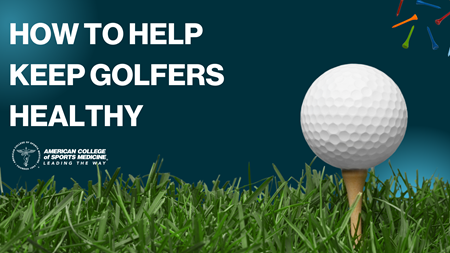by
Greg Margason
| Aug 25, 2022

Golf is a sport played by millions of people worldwide. It is unique in the fact that it can be enjoyed by people of all ages and skill levels. And notably, with our recent pandemic, golf provided us a great way to stay active outdoors while still practicing safe social distancing, which has only increased the popularity of the sport.
Unfortunately, some see golfers as not physically fit, but hopefully this is a misconception we can leave in the past. Recent changes at the professional level include increased focus on speed and power, and this emphasis is now seen at all levels of the game. Not only do golfers want to swing faster to increase club head and ball speeds, but they want to be efficient.
There is not one perfect golf swing but rather an infinite number of swing styles based on the most efficient way to hit a golf ball given the golfer’s physical fitness and movement quality. A golf-specific physical screen and swing analysis will help guide the clinician in predicting injury patterns in an individual athlete because golfers often exhibit injury-inducing swing mechanics that are a direct result of a stability or mobility issue.
Golf injuries can be categorized like most into acute and chronic. These are often a result of overuse and related to the repetitive, asymmetric, and rotational nature of the sport. While it is thought that most elite golfers are injured secondary to overuse, the amateur golfer is more likely to be injured due to poor swing mechanics.
Common golf injuries most often involve the low back, elbow, shoulder, wrist and knee. Low back pain is universally found to be the leading cause of issues for golfers of all ages and skill levels. However, while the low back is often the source of pain, it is typically not the cause. It is important to not only focus on this area when evaluating an injured golfer but to also look closely at the mobility of the thoracic spine above and the hips below. When these regions have limited motion, the lumbar spine must rotate more than it is accustomed to, resulting in unwanted stress to the area and eventually to pathologies such as lumbar muscle strain, stress fracture, intervertebral disc disease and herniation, and facet joint arthropathy.
To help prevent injury to the low back, the clinician should emphasize the importance of a dynamic warm-up before each practice session or round of golf. Like athletes in all other sports, golfers will benefit most from starting off with mobile joints, relaxed muscles and increased blood flow to the muscles used to hit the golf ball.
Posture also plays a key role, from the address position to the follow-through. Often, lower crossed syndrome causes the golfer to address the ball with too much thoracic kyphosis, lumbar lordosis and anterior pelvic tilt, which can lead to stress to the low back. To address this problem, gluteus maximus and rectus abdominus weakness and inflexible erector spinae and hip flexors should be identified and corrected. If overlooked, the golfer will frequently find themselves with swing characteristics, such as reverse spine angle or early extension, that will result in lower back pain over time.
For most, time spent playing golf tends to increase as we age, which makes identifying these problems sooner rather than later even more important. All golfers would likely agree, the ultimate goal is to be able to play well and enjoy this exceptional game for a lifetime.
Additional resources:
Blog | How to Modify Programs for Clients and Athletes With Injuries
Video | Using Sport Injury Surveillance Data to Study Injury Outcomes
Call to Action | Increasing the Availability of Automated External Defibrillators at Sporting Events
 Drew Duerson, M.D., RMSK, is a Sports Medicine physician at Nationwide Children’s Hospital in the Division of Sports Medicine. He is the medical director of the Nationwide Children’s Hospital Golf Medicine Program. He is also a clinical associate professor of Pediatrics at the Ohio State University. He received a bachelor’s degree from Bellarmine University where he was an academic all-american in golf. He received his medical degree from the University of Louisville School of Medicine. He completed his Pediatric residency followed by a Sports Medicine fellowship at Nationwide Children’s Hospital. Drew is a board-certified Pediatrician with a certificate of added qualification in Sports Medicine. He is Titleist Performance Institute Medical 2 Certified and the only TPI certified physician in central Ohio.
Drew Duerson, M.D., RMSK, is a Sports Medicine physician at Nationwide Children’s Hospital in the Division of Sports Medicine. He is the medical director of the Nationwide Children’s Hospital Golf Medicine Program. He is also a clinical associate professor of Pediatrics at the Ohio State University. He received a bachelor’s degree from Bellarmine University where he was an academic all-american in golf. He received his medical degree from the University of Louisville School of Medicine. He completed his Pediatric residency followed by a Sports Medicine fellowship at Nationwide Children’s Hospital. Drew is a board-certified Pediatrician with a certificate of added qualification in Sports Medicine. He is Titleist Performance Institute Medical 2 Certified and the only TPI certified physician in central Ohio.
He is a member of the Sports Medicine fellowship faculty at Nationwide Children's and the team physician for Canal Winchester high school. He is a fellow of the American Academy of Pediatrics and an active member of the American College of Sports Medicine, American Medical Society of Sports Medicine and American Institute of Ultrasound in Medicine. His clinical areas of interest include musculoskeletal ultrasound and the diagnosis, treatment, and prevention of golf injuries in the young athlete.